- Clone
- OX-104 (See other available formats)
- Regulatory Status
- RUO
- Workshop
- VII 70655
- Other Names
- OX-2, OX2
- Isotype
- Mouse IgG1, κ
- Barcode Sequence
- CACGTAGACCTTTGC
- Ave. Rating
- Submit a Review
- Product Citations
- publications
CD200, also known as OX2, is a member of the immunoglobulin superfamily (IgSF). It is a monomorphic cell surface glycoprotein that is expressed on thymocytes, neurons, endothelium, follicular dendritic cells in all lymphoid organs, a subset of CD34+ progenitor cells, and at low levels on some smooth muscle and B lymphocytes. It is not expressed on NK cells, monocytes, granulocytes, or platelets. CD200 costimulates T cell proliferation. It may regulate myeloid cell activity in a variety of tissues. The interaction between CD200 (OX2) and CD200 receptor (OX2R) system is of importance in the control of macrophage and granulocyte activation, which may contribute to pathways that suppress and limit macrophage induced inflammatory damage in tissue.
Product DetailsProduct Details
- Verified Reactivity
- Human
- Reported Reactivity
- African Green, Baboon
- Antibody Type
- Monoclonal
- Host Species
- Mouse
- Formulation
- Phosphate-buffered solution, pH 7.2, containing 0.09% sodium azide and EDTA
- Preparation
- The antibody was purified by chromatography and conjugated with TotalSeq™-D oligomer under optimal conditions.
- Concentration
- 0.5 mg/mL
- Storage & Handling
- The antibody solution should be stored undiluted between 2°C and 8°C. Do not freeze.
- Application
-
PG - Quality tested
- Recommended Usage
-
Each lot of this antibody is quality control tested by immunofluorescent staining with flow cytometric analysis and the oligomer sequence is confirmed by sequencing. TotalSeq™-D antibodies are compatible with Mission Bio’s Tapestri Single-Cell Sequencing Platform for simultaneous detection of DNA and Protein.
To maximize performance, it is strongly recommended that the reagent be titrated for each application, and that you centrifuge the antibody dilution before adding to the cells at 14,000xg at 2 - 8°C for 10 minutes. Carefully pipette out the liquid avoiding the bottom of the tube and add to the cell suspension. For Proteogenomics analysis, the suggested starting amount of this reagent for titration is ≤ 1.0 µg per million cells in 100 µL volume. Refer to the corresponding TotalSeq™ protocol for specific staining instructions.
Buyer is solely responsible for determining whether Buyer has all intellectual property rights that are necessary for Buyer's intended uses of the BioLegend TotalSeq™ products. For example, for any technology platform Buyer uses with TotalSeq™, it is Buyer's sole responsibility to determine whether it has all necessary third party intellectual property rights to use that platform and TotalSeq™ with that platform. - Application Notes
-
Additional reported applications (for the relevant formats) include: immunohistochemistry of formalin-fixed paraffin-embedded sections1 and acetone-fixed frozen sections2, and blocking of CD200 interaction with CD200R.
- Additional Product Notes
-
TotalSeq™-D reagents are designed to profile protein expression at single cell level. The Mission Bio Tapestri platform and sequencer (e.g. Illumina analyzers) are required. Please contact technical support for more information, or visit biolegend.com/totalseq/single-cell-dna
The barcode flanking sequences are CGAGATGACTACGCTACTCATGG (PCR handle), and GAGCCGATCTAGTATCTCAGT*C*G (capture sequence). * indicates a phosphorothioated bond, to prevent nuclease degradation.
View more applications data for this product in our Application Technical Notes. -
Application References
(PubMed link indicates BioLegend citation) -
- Patel GK, et al. 2012. J. Invest. Dermatol. 132:401. (IHC)
- Wright GJ, et al. 2001. Immunology 102:173. (IHC)
- Foster-Cuevas M, et al. 2004. J. Virol. 78:7667. (FC)
- RRID
-
AB_2892395 (BioLegend Cat. No. 329231)
Antigen Details
- Structure
- Immunoglobulin superfamily
- Distribution
-
T cells, neurons, endothelium
- Function
- Costimulates T cell proliferation
- Receptors
- CD200R
- Cell Type
- Endothelial cells, Neurons, T cells
- Biology Area
- Cell Biology, Costimulatory Molecules, Immunology, Neuroscience, Neuroscience Cell Markers
- Molecular Family
- CD Molecules
- Antigen References
-
1. Wright GJ, et al. 2001. Immunol. 102:173.
2. Foster-Cuevas M, et al. 2004. J. Virol. 78:7667.
3. Mason D, et al. 2002. ed. Leukocyte Typing VII. New York:Oxford Univ. Press.
4. Broderick C, et al. 2002. Am. J. Pathol. 161:1669. - Regulation
- Induces a downregulation of macrophage activity
- Gene ID
- 4345 View all products for this Gene ID
- UniProt
- View information about CD200 on UniProt.org
Related Pages & Pathways
Pages
Related FAQs
Other Formats
View All CD200 Reagents Request Custom ConjugationCompare Data Across All Formats
This data display is provided for general comparisons between formats.
Your actual data may vary due to variations in samples, target cells, instruments and their settings, staining conditions, and other factors.
If you need assistance with selecting the best format contact our expert technical support team.
-
Purified anti-human CD200 (OX2)

Human peripheral blood lymphocytes were stained with CD4 APC... -
Biotin anti-human CD200 (OX2)
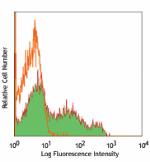
Human peripheral blood lymphocytes stained with biotinylated... -
PE anti-human CD200 (OX2)
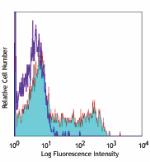
Human peripheral blood lymphocytes stained with OX-104 PE -
APC anti-human CD200 (OX2)
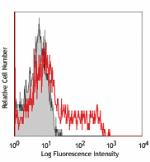
Human peripheral blood lymphocytes stained with OX-104 APC -
Brilliant Violet 421™ anti-human CD200 (OX2)

Human peripheral blood lymphocytes were stained with CD200 (... -
PE/Cyanine7 anti-human CD200 (OX2)
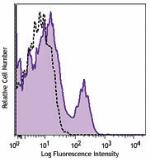
Human peripheral blood lymphocytes were stained with CD200 (... -
Alexa Fluor® 647 anti-human CD200 (OX2)
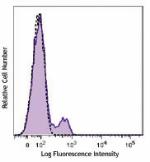
Human peripheral blood lymphocytes were stained with CD200 (... -
PerCP/Cyanine5.5 anti-human CD200 (OX2)

Human peripheral blood lymphocytes were stained with CD4 APC... -
Brilliant Violet 605™ anti-human CD200 (OX2)
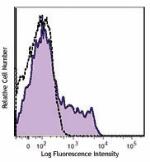
Human peripheral blood lymphocytes were stained with CD200 (... -
Purified anti-human CD200 (OX2) (Maxpar® Ready)

Human PBMCs stained with 149Sm-anti-CD200 (OX-104). B cells ... -
APC/Cyanine7 anti-human CD200 (OX2)

Human peripheral blood lymphocytes were stained with CD4 APC... -
Brilliant Violet 711™ anti-human CD200 (OX2)
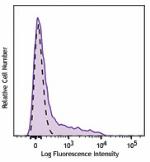
Human peripheral blood lymphocytes were stained with CD200 (... -
APC/Fire™ 750 anti-human CD200 (OX2)

Human peripheral blood lymphocytes were stained with CD200 (... -
Ultra-LEAF™ Purified anti-human CD200 (OX2)
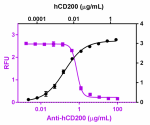
Recombinant biotinylated hCD200 (Black circles, Cat. No. 770... 
Human peripheral blood lymphocytes were stained with CD4 APC... -
TotalSeq™-C0447 anti-human CD200 (OX2)
-
TotalSeq™-D0447 anti-human CD200 (OX2)
-
TotalSeq™-A0447 anti-human CD200 (OX2)
-
TotalSeq™-B0447 anti-human CD200 (OX2)
-
Spark YG™ 581 anti-human CD200 (OX2)

Human peripheral blood lymphocytes were stained with anti-hu... -
PE/Fire™ 700 anti-human CD200 (OX2)

Human peripheral blood lymphocytes were stained with anti-hu...













Follow Us